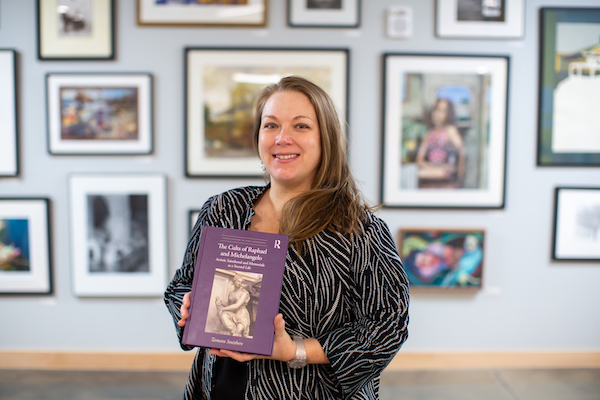Austin Peay art history professor publishes book about ‘artistic sainthood’ of Michelangelo, Raphael

CLARKSVILLE, Tenn. – After more than 10 years of research – including several trips to Italy – Austin Peay State University art history professor Dr. Tamara Smithers has finished her book.
“This is my career goal, and so I feel like I have achieved it,” she said. “But my dream also is to have it read and well received.”
The book – The Cults of Raphael and Michelangelo: Artistic Sainthood and Memorials as a Second Life – explores how the two artists inspired fervent followings like no artists before them. Routledge published the book earlier this year.
“I am looking forward to going to conferences and meeting people who say, ‘Oh, Tamara Smithers, I read this book by you,’” she said. “I want people to have enjoyed it and learn something from it. That’s my ultimate goal.”
Smithers also talks about the book and teaching at Austin Peay in “Govs on the Go: Faculty Spotlight.” Her episode was posted on Dec. 19.
Cult of ‘the Divine One’
In the book, Smithers examines “the phenomenon of the cults of Raphael and Michelangelo in relation to their death, burial and posthumous fame – or second life – from their own times through the 19th century.”
She studied Michelangelo for both her master’s and Ph.D. work, and “one of the things that I found missing in the scholarship were in-depth discussions about his nickname, ‘Il Divino.’
“He was called ‘the Divine One’ during his own time, and I became increasingly fascinated with this idea,” she said. “‘How did people act around him? If they thought of him as divine-like, what did that mean? How did people treat him? How did they regard things he owned or his artworks?’”
Smithers discusses five centuries of adoration for Michelangelo and Raphael – and the artists who came after them.
“Part of the book focuses on memorials,” she said. “I look at how those spaces were important. Then I look at artists’ tombs in general and make a lot of comparisons. I look at tombs before Raphael and Michelangelo and how their tombs influenced other artists’ tombs, and then I take the cult following of Raphael and Michelangelo all the way to the 19th century.”
The book’s summary helps to paint the picture: The two artists “opened up new avenues of artistic fame, divination and commemoration. Within this cultural framework, this study charts the elevation of the status of dozens of other artists in Italy through funerals and tomb memorialization, many of which were held and made in response to those of Raphael and Michelangelo.”
Smithers wrote the book for scholars who study early modern Italy, art history, cultural history and Italian studies but it is written in a way that is accessible to students (and it includes a glossary).
Capturing photos for the book
To help readers envision her discussions, Smithers traveled several times to Italy, including a 2020 trip as a visiting artist scholar at the American Academy in Rome, where she spent dozens of hours with the Arthur and Janet C. Ross Library’s 167,000 volumes on classical studies and art. She also traveled the country taking photos for the book, which has 128 illustrations.
“A lot of those were taken by me,” she said. “I went to these tombs and took the photograph. That was the most important thing for me because I wanted the book to be well illustrated because that’s what makes it art history, being able to see the evidence of these things.”
The cover includes one of Smithers’ photos – a detail shot of Michelangelo’s tomb designed by Giorgio Vasari, which includes three sculptures that depict the personifications of painting, sculpture and architecture. The figures appear saddened by the death of a master. The figure on Smithers’ cover is the figure that depicts painting (originally sculpture) carved by Battista Lorenzi.
Smithers also travels to Italy to lead a study abroad trip, “Art in Rome,” for Austin Peay students. On the trip next summer, she plans to assign chapters from the book so the students can see firsthand what they’re reading. She also integrates what she learns into her classes.
Other work
Smithers’ book follows her work as editor and contributor to Michelangelo in the New Millennium: Conversations About Artistic Practice, Patronage and Christianity in 2016.
She also wrote an essay titled “Who was Michelangelo” – meant to be easy to understand for all students – for Smarthistory.
And coming next year, Benna Books is expected release her Short Biography of Michelangelo geared toward anyone interested in art and culture, young adults and museum-goers.
Woodward Library at Austin Peay has two copies of The Cults of Raphael and Michelangelo: Artistic Sainthood and Memorials as a Second Life, one in Special Collections signed and donated by the author.
News Feed
View All NewsNo items to display